Trở Về Trang Gốc Lịch Sử Việt Nam
Lịch Sử Việt Nam - phần 13
121. Chiến tranh Nam Bắc 1954 -1975: Sau 1954, nhân dân miền Bắc sống nghèo đói dưới chế độ độc tài Cộng Sản, trong khi nhân dân miền Nam sống trong no ấm, tự do . Theo tinh thần hiệp định Geneve 1954, dân chúng được quyền tự do lựa chọn miền đất mà mình muốn sinh sống, rồi sau đó 2 năm sẽ có một cuộc Tổng tuyển cử toàn quốc để người dân được lựa chọn người lãnh đạo đất nước. Nhưng từ những ngày đầu, Cộng sản đã vi phạm trầm trọng hiệp định Geneve. Tại vùng quê miền Bắc, Cộng sản ngăn cản không cho dân chúng di cư vào miền Nam. Họ còn bắt giam, thậm chí bắn chết các thuyền nhân vượt biên vào Nam. Ở miền Nam, Cộng sản chôn dấu vũ khí trong vùng quê chờ ngày thực hiện chiến tranh phá hoại. Họ còn gài cán bộ Cộng sản ở lại miền Nam để xúi dục dân chúng phá hoại kết quả cuộc bầu cử sắp diễn ra. Biết được mưu toan đó Tổng thống Ngô Đình Diệm đã hủy bỏ cuộc Tổng tuyển cử và quyết tâm xây dựng một chính quyền vững mạnh để bảo vệ miền Nam tự do. Cộng Sản Bắc Việt khôn khéo lập nên Mặt Trận Giải Phóng Miền Nam để che đậy sự xâm lăng. Với súng đạn của Liên Xô và Trung Cộng, họ bắt đầu ám sát nhân viên chính quyền miền Nam, rồi sau đó ào ạt tấn công miền Nam đang sống trong hòa bình, no ấm. Một mặt họ tuyên truyền láo khoét về một xã hội miền Bắc tốt đẹp không có trong thực tế để lôi cuốn nông dân và những người nhẹ dạ ở miền Nam. Mặt khác, họ tuyên truyền với người dân miền Bắc về một cuộc xăm lăng của "đế quốc Mỹ" đang giết hại nhân dân miền Nam. Với nghệ thuật tuyên truyền khéo léo, họ dần dần chiếm được cảm tình của một số nông dân miền Nam và đưa được người vào chính quyền để phá hoại nền dân chủ non trẻ mà người dân miền Nam mới gây dựng được. Trong suốt cuộc chiến, hay trong cơn lửa đạn, người ta luôn nhìn thấy hình ảnh đồng chạy về phía những người lính Việt Nam Cộng Hoà và xa lánh quân đội Cộng Sản. Người ta nhìn thấy quân đội Việt Nam Cộng Hoà hay mở vòng tay đón tiếp, cứu giúp đồng bào, trong khi quân đội Cộng Sản hay pháo kích, bắn vào người dân di tản chiến tranh. Sau khi Cộng Sản chiếm được miền Nam, người ta vẫn còn thấy cảnh người dân trốn chạy Cộng Sản, bỏ nước ra đi tới hơn 20 năm sau.
The North-South war, 1954-1975: From 1945, the North suffered from a dictatorial communist regime, while the South was a prosperous and free country. By the Geneva agreement of 1954, the Vietnamese could choose the land that they want to live on. Then there would be a general election to select the country leader after 2 years. But from the first day, the communists continued to violate the agreement. In the North, the communists prohibited people to go to the South; they imprisoned, shot and killed many refugees. In the South, they buried the weapons, installed communist cadres to prepare for the war and to disturb the results of the election if needed. Knowing that plan, president Ngo Dinh Diem refused to join the election and was resolved to build up a strong government to protect the South from the communists. Taking that chance the communists started to attack the South. They created the “South Liberation Front” to disguise their invasion. With a large number of weapons from the Soviet Union and China, they attacked the South while people were living a peaceful life. On one hand, they complained about the “invasion” by American army. On the other hand, they tried to persuade the southern farmers to side with them, using beautiful descriptions of the North that nobody ever seen. With their clever use of propaganda accompanying with terrorist acts, the VC gradually gained support from many southerners and succeeded in installing their spies into the southern government to destroy the young democracy that the South was just building up.
La guerre Nord-Sud de 1954-1975: A partir de 1954, le Nord souffrit d'un régime dictatorial communiste, tandis que le Sud fut un pays prospère et libre. Selon la convention de Genève de 1954, les viêtnamiens purent choisir le pays où ils voulaient vivre. Ensuite il aurait dû y avoir une élection générale pour choisir le chef du pays dans les 2 ans. Mais dès le premier jour, les communistes se mirent à violer l'accord. Dans le Nord, les communistes interdirent aux gens d’aller au Sud ; Ils emprisonnèrent, tirèrent et abattirent beaucoup de réfugiés. Dans le Sud, ils enterrèrent les armes, installèrent des cadres communistes pour préparer la guerre et perturber les résultats de l'élection, si nécessaire. Connaissant ce plan, le président Ngô Dình Diêm refusa d'adhérer à l'élection et se résolut à mettre en place un gouvernement fort pour protéger le Sud des communistes. Prenant cette chance, les communistes commencèrent à attaquer le Sud. Ils créèrent le « Front de libération du Sud » pour dissimuler leur invasion. Avec un grand nombre d'armes en provenance de l'Union soviétique et de la Chine, ils attaquèrent le Sud alors que les gens vivaient une vie paisible. D'une part, ils se plaignirent de « l'invasion » par l'armée américaine. D'autre part, ils essayèrent de persuader les agriculteurs du Sud de se joindre à eux en utilisant de belles descriptions du Nord que personne n'avait jamais vu. Avec leur utilisation habile de la propagande accompagnée d’actes terroristes, le viêt công gagna progressivement le soutien de nombreux habitants du sud et réussit à installer leurs espions dans le gouvernement pour détruire la jeune démocratie que le Sud commençait à mettre en place.
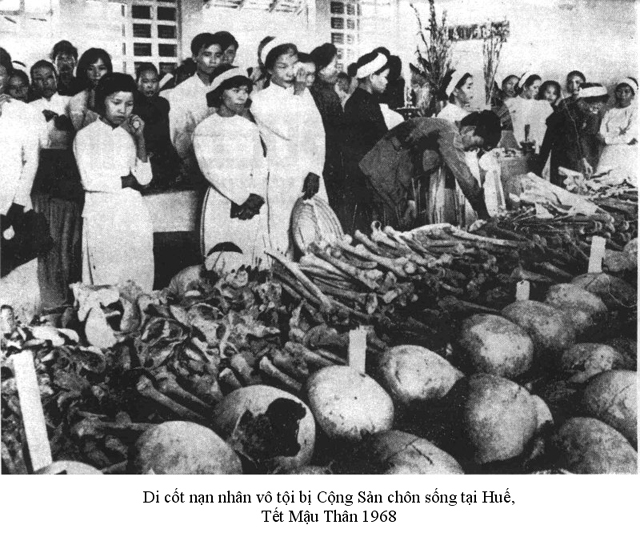 Những hình ảnh nầy ghi rất đậm nét tội trạng giết hại đồng bào vô tội của Cộng Sản Việt Nam
Những hình ảnh nầy ghi rất đậm nét tội trạng giết hại đồng bào vô tội của Cộng Sản Việt Nam122. Cuộc Tấn Công Tết Mậu Thân, 1968: Hàng năm vào các ngày Tết Âm lịch, Việt Cộng đề nghị hưu chiến để quân dân hai bên có dịp đoàn tụ với gia đình trong những ngày đầu năm. Lợi dụng những ngày hưu chiến Tết Mậu Thân 1968, vào giờ giao thừa thiêng liêng của dân tộc, Việt Cộng tấn công vào hơn 40 tỉnh lỵ và thành phố lớn của miền Nam. Cuộc tấn công chia làm 3 đợt lớn, họ chiếm được một vài thành phố trong một thời gian ngắn nhưng sau cùng họ bị quân đội miền Nam và quân đội Đồng minh đẩy lui với những tổn thất rất nặng nề. Phía Việt Cộng có khoãng 55 ngàn binh sĩ tử thương và hơn 10 ngàn bị bắt sống. Phía miền Nam có hơn 5 ngàn binh sĩ tử thương và khoảng 1 ngàn bị mất tích. Phía quân đội Đồng Minh có khoảng 5 ngàn binh sĩ tử thương. Nhưng đau đớn nhất là số thường dân miền Nam bị thiệt mạng trên 14 ngàn người trong đó có trên 3 ngàn người bị Cộng quân chôn sống hoặc giết chết một cách dã man tại Huế. Trong hơn 50 hầm chôn tập thể ở Huế người ta thấy có cả đàn bà và trẻ em. Những xác đào lên cho thấy những người dân bạc phước ấy bị đập vào đầu, bị chặt đầu, chặt tay chân, hoặc bị chôn sống khi bị trói từng chùm từ 10 đến 15 người . Trong số những người bị Việt Cộng thảm sát có em bé trai 5 tuổi và em bé gái 3 tuổi con ông Phạm Văn Tường làm nghề gác cửa cho ty Thông tin. Việt Cộng bắn chết ông Tường, hai đứa con và 2 đứa cháu nhỏ của ông trước một căn hầm gần nhà.
The Tet Mau Than Offensive, 1968: Taking advantage of the truce during the 1968 Tet holiday, Viet Cong guerrillas attacked more than 40 counties and cities of the South on new year’s eve. The attacks came in three waves. At first, the VC captured a few cities in a short time. Later, they were expelled and sufferred heavy losses by the combined forces of the South and the allied forces. There were 55,000 deaths and 10,000 captives on the VC side. The South lost more than 5,000 soldiers and 1,000 captives. There were 5,000 deaths among the allied forces. But the worst part was that more than 14,000 innocent people were killed. Among them were more than 3,000 who were savagely killed or buried alive by the VC at Hue City. In more than 50 common graves created by the communists, people have found even bodies of women and children. The exhumation showed the unfortunate victims were struck on the head, decapitated, had their arms and legs chopped off, or were even buried alive, tied together in groups of ten to fifteen. Among those painful victims, there were a boy of five and a girl of three years old. They were the children of Mr. Pham Van Tuong who was the door guard of a communication office. The VC shot Mr. Tuong, his two children, and his two nephews in front of a trench next to his house.
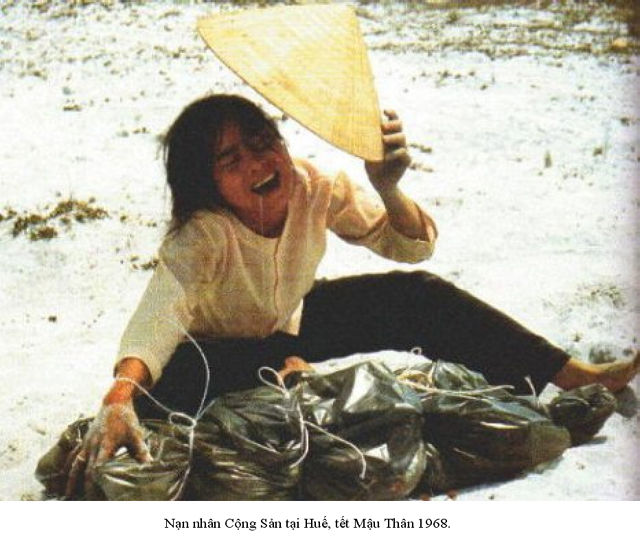
L’Offensive du Têt Mâu Thân, 1968: Profitant de la trêve pendant la fête du Têt de 1968, les guérilleros viêt công attaquèrent plus de 40 comtés et grandes villes du Sud à la veille du nouvel an. Les attaques survinrent en trois vagues. Au début, le viêt công captura quelques villes en peu de temps. Plus tard, ils furent expulsés et eurent à subir de lourdes pertes par les forces combinées du Sud et alliées. Il y eu 55000 morts et 10000 prisonniers du côté viêt công. Le Sud perdit plus de 5000 soldats et 1000 prisonniers. Il y eut 5000 morts parmi les forces alliées. Mais le pire c'est que plus de 14000 personnes innocentes furent tuées. Parmi elles, plus de 3000 furent sauvagement tuées ou enterrées vivantes par le viêt công dans la ville Huê. Des corps de femmes et d'enfants ont même trouvés dans plus de 50 fosses communes créées par les communistes. L'exhumation a montré que les malheureuses victimes avaient été frappées à la tête, décapitées, avaient les bras et les jambes coupées, ou ont même été enterrées vivantes, liées ensembles par groupes de dix à quinze. Parmi ces victimes douloureuses, on trouva un garçon de cinq ans et une fille de trois ans. C’étaient les enfants de M. Pham Van Tuòng qui était le garde de la porte d'un bureau de la communication. Le viêt công abattit M. Tuòng, ses deux enfants et ses deux neveux en face d'une tranchée, à côté de sa maison.
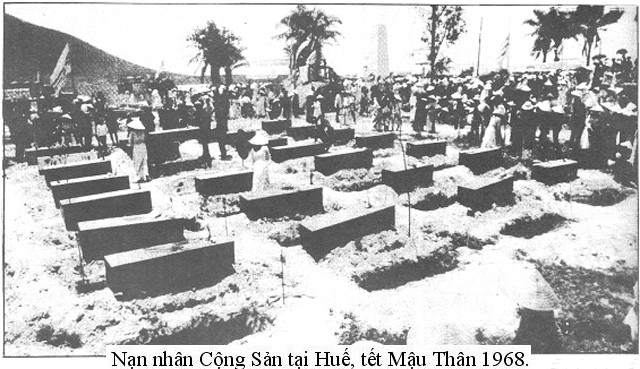
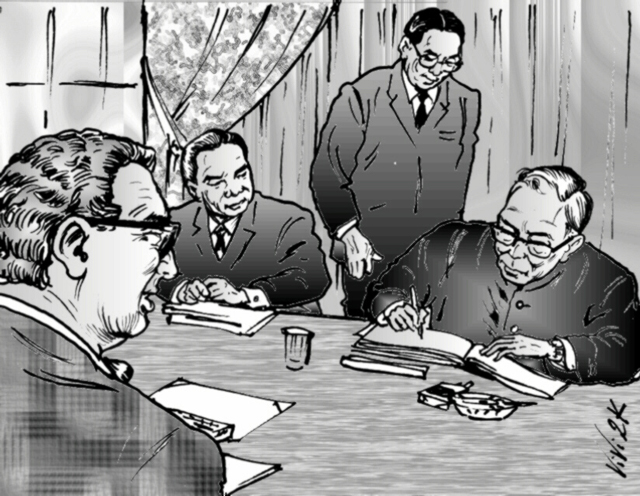
123. Hiệp định Hòa bình Paris, 1973: Bị khó khăn với các phe phản chiến tại nước nhà, chính phủ Hoa Kỳ không thể tiếp tục viện trợ dồi dào cho miền Nam Việt Nam trong công cuộc chống Cộng. Hoa Kỳ và Cộng sản Bắc Việt hội nghị ở Paris hơn một năm để tìm một giải pháp hòa bình cho cuộc chiến ở Việt Nam. Ngày 27 tháng 1 năm 1973 hiệp định hòa bình Paris được ký kết giữa Hoa Kỳ và Bắc Việt. Hiệp định nầy gồm 9 chương và 23 điều quy định những thể thức ngưng bắn, rút quân, tổng tuyển cử ở miền Nam để nhân dân miền Nam được tự quyết số phận của mình. Hiệp định qui định về cách thành lập các Ủy ban Liên Hợp Quân Sự Bốn bên, các ủy hội Kiểm Soát và Giám Sát Quốc Tế. Hiệp định cũng ấn định về các tái thiết hậu chiến cho Việt Nam và cả Đông Dương. Về phía Hoa Kỳ, hiệp định Paris là cơ hội cho họ rút quân ra khỏi Việt Nam trong danh dự, chấm dứt sự liên hệ vào một cuộc chiến tốn kém nhiều tiền bạc và sinh mạng của quân đội Hoa Kỳ. Về phía Việt cộng, đây là một cơ hội tốt cho họ tấn công và chiếm trọn miền Nam mà không có sự can thiệp của quân đội Mỹ. Ngay trước khi hiệp định được ký kết, cán binh Việt cộng đã được học tập kỹ lưỡng về các kế hoạch vi phạm hiệp định, tiến chiếm, dành dân lấn đất. Sau đó thay vì ngưng bắn xây dựng hòa bình như tinh thần của hiệp định Paris, Việt cộng lại tấn công mạnh mẽ hơn để cuối cùng chiếm trọn miền Nam, năm 1975.
The Paris Peace Treaty in 1973: Having difficulty with the anti-war movement at home, the U. S. government could not continue to help the South government to fight the communists. The U. S. government and the Communists met in Paris for more than 1 year to find a peaceful solution for the Vietnam war. On January 27, 1973, the Paris Peace Treaty was signed by the U. S., the North, the South of Vietnam and the Liberation Front. The Treaty included 9 chapters and 23 articles, establishing the rules to cease-fire, to withdraw the armies, and to have general election at the South so the southerners can make decision for their own future. The Peace Treaty schemed the building of the Four-Side Army Committee, and the International Control Committees. The Treaty also planned for the post-war rebuild for Vietnam and for the entire Indochina. For the United States, the Treaty is a good chance to withdraw its army from Vietnam, ending an expensive war. For the VC, the Treaty is a wonderful opportunity for them to seize the South without the obstruction of the U. S. army. Similar to the Geneva agreement, before the treaty was signed, the communists already had a plan to break the agreement to capture the South. Instead of peacefully following the 1973 Treaty, the communists attacked the South with all of their strength to finally capture the South in 1975.
Le traité de paix de Paris en 1973: Ayant des difficultés avec le mouvement anti-guerre dans son pays, le gouvernement américain ne put continuer à aider le gouvernement du Sud à lutter contre les communistes. Le gouvernement américain et les communistes se réunirent à Paris pendant plus d’un an pour trouver une solution pacifique à la guerre du Viêt-Nam. Le 27 Janvier 1973, le traité de paix de Paris fut signé par les Etats-Unis, le Nord, le Sud du Viêt-Nam et le Front de Libération. Le Traité comprenait 9 chapitres et 23 articles, établissant les règles de cessez-le-feu, de retrait des armées et de tenue d’élections générales dans le Sud de sorte que les sudistes puissent prendre des décisions pour leur propre avenir. Le traité de paix projetait la construction d’un comité quadripartite de l’armée, et de comités de contrôle international. Le traité prévoyait également la reconstruction du Viêtnam et de toute l’Indochine après-guerre. Pour les États-Unis, le traité fut une bonne chance de retirer leur armée du Viêt-Nam, mettant fin à une guerre coûteuse. Pour le viêt công, le traité fut une merveilleuse occasion de s'emparer du Sud sans l'obstruction de l'armée américaine. Semblable à l'accord de Genève, avant que le traité ait été signé, les communistes avaient déjà un plan visant à le rompre pour capturer le Sud. Au lieu d’appliquer tranquillement le Traité de 1973, les communistes attaquèrent le Sud avec toutes leurs forces pour le capturer enfin en 1975.
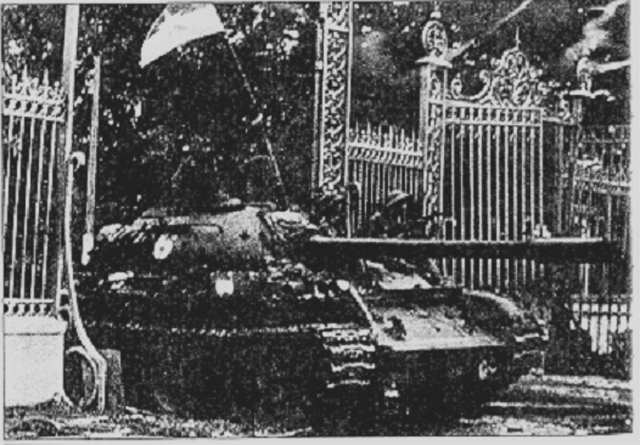 Ngày
30 tháng 4 năm 1975, một chiếc xe tăng Cộng sản Bắc Việt do Liên Xô chế
tạo đã ủi sập cổng trước dinh Tổng Thống Việt Nam Cộng Hòa, ủi sập luôn
nền dân chủ non trẻ, mà dân tộc Việt Nam xây dựng lần đầu tiên trong
mấy ngàn năm lịch sử của mình. Sau đó cả đất nước Việt Nam đi ngược
dòng tiến hóa, sống trong xã hội độc tài Cộng Sản. Xã hội bất công và
thối nát, dân chúng lầm than hơn trong các chế độ phong kiến vua chúa
ngày xưa nhiều lần.
Ngày
30 tháng 4 năm 1975, một chiếc xe tăng Cộng sản Bắc Việt do Liên Xô chế
tạo đã ủi sập cổng trước dinh Tổng Thống Việt Nam Cộng Hòa, ủi sập luôn
nền dân chủ non trẻ, mà dân tộc Việt Nam xây dựng lần đầu tiên trong
mấy ngàn năm lịch sử của mình. Sau đó cả đất nước Việt Nam đi ngược
dòng tiến hóa, sống trong xã hội độc tài Cộng Sản. Xã hội bất công và
thối nát, dân chúng lầm than hơn trong các chế độ phong kiến vua chúa
ngày xưa nhiều lần. Le 30 avril 1975, un tank Nord Viêtnamien communiste de fabrication soviétique enfonça les grilles du palais du Président de la République du Viêt-Nam du Sud, par cette action il écrasa aussi la première démocratie naissante au Viêt-Nam après des milliers d’années d’histoire du Viêt-Nam.
124. Việt Cộng cưỡng chiếm miền Nam năm 1975: Cộng Sản Bắc Việt dùng chiêu bài "Chống Mỹ cứu nước" để lường gạt nhân dân Việt Nam và thế giới . Mục tiêu thật sự của họ là Cộng Sản hóa nước Việt Nam dưới sự lãnh đạo của đảng Cộng Sản độc tài. Với sự hỗ trợ mạnh mẽ về súng đạn của Liên Xô, Trung Cộng, Cộng Sản dần dần thắng thế trong công cuộc phá rối xã hội miền Nam. Cùng lúc đó chính quyền miền Nam rối ren vì những cuộc đảo chánh nối tiếp nhau, vì những tướng lãnh bất tài, không có lòng yêu nước thay nhau nắm chính quyền làm mất lòng dân. Vì quyền lợi nước Mỹ không còn trực tiếp dính líu tới miền Nam và vì áp lực của các lực lượng phản chiến tại nước Mỹ, chính quyền miền Nam không còn được tiếp tế đầy đủ như trước. Quân đội miền Nam trở nên yếu thế, dù rằng quân nhân miền Nam vẫn còn chiến đấu anh dũng để bảo vệ quê hương. Ngày 30 tháng 4 năm 1975, sau nhiều ngày rối ren, miền Nam thất thủ. Một số tướng lãnh như tướng Nguyễn Khoa Nam, tướng Lê Văn Hưng, tướng Trần Văn Hai, tướng Phạm Văn Phú, tướng Lê Nguyên Vỹ tuẫn tiết, một số ở lại bị Việt Cộng giết như Đại tá Hồ Ngọc Cẩn. Một số bỏ nước ra đi, phần còn lại bị Việt Cộng bắt giam, đày đọa trong các trại tập trung. Nhìn trở lại, quân đội miền Nam đã anh dũng chiến đấu để bảo vệ quê hương tự do. Nhưng người Cộng Sản đã khéo léo hơn trong lãnh vực tuyên truyền và tổ chức. Họ đã huấn luyện quần chúng thành một đội binh "quân đội nhân dân" mà mọi người phải đóng góp vào cuộc chiến. Gián điệp của họ đã xâm nhập vào xã hội lỏng lẻo của miền Nam tạo nên tình trạng hỗn độn, rối ren để cho Bắc quân có thể đánh bại miền Nam. Trong suốt cuộc chiến, miền Băc thiệt hại 1 triệu rưỡi binh lính, miền Nam mất khoãng 400 ngàn, quân đội Hoa Kỳ đã mất 58 ngàn cùng với binh sĩ Đồng Minh khi giúp đỡ miền Nam. Ngoài ra còn vài triệu người dân vô tội đã chết trên trong cuộc chiến. Ai cũng có thể thấy cuộc chiến Việt Nam không cần phải có, vì chế độ Cộng sản chỉ là một chế độ độc tài, khát máu, không tôn trọng người dân, không cần thiết cho đất nước Việt Nam hay bất cứ đất nước nào trên thế giới. Thiên đường Cộng Sản mà họ diễn tả cũng chưa bao giờ hiện diện mà chỉ có những nước Cộng Sản với đầy dẫy những sự nghèo đói, giết chóc, bắt bớ, hận thù. Khẩu hiệu "Chống Mỹ cứu nước" chỉ là những lời vô nghĩa vì Hoa Kỳ chưa hề xâm chiếm Việt Nam. Sau khi Cộng Sản đánh đuổi người Mỹ đi, một thời gian ngắn sau, cũng chính họ cung kính mời người Mỹ vào.
Viet Cong captured the South in 1975: The northern communists used the slogan “Fight the Americans to save the country” to deceive the Vietnamese and the world. Their actual goal was to communize Vietnam under the dictatorial communist party. With massive help from the Soviet Union and China, the communists gradually won the war. At the same time, the southern government was destabilized by many coups d’etat, with army generals who had no patriotic hearts taking turns to govern the South. Because the interests of the United States were not directly related to South Vietnam, and with strong pressure from anti-war forces at home, the U.S. government stopped aiding to the South. The Southern army became weaker even though most of the soldiers still bravely fought to protect their homeland. In April 30 of 1975, after many days in chaos, the South surrendered. Some respectable generals, including Nguyen Khoa Nam, Le Van Hung, Tran Van Hai, Pham Van Phu, and Le Nguyen Vy, committed suicide. Others, such as Colonel Ho Ngoc Can, was killed by the communists. Many soldiers escaped to overseas and a large number were gathered in concentration camps. Looking back, the southern soldiers were very brave in defending their freedom and their motherland. But the communists were much clever in propaganda, organization and use violent force. They trained the general public to be the “people army” where everybody had to contribute toward the war. Their spies broke into the loose society of the South, caused confusion and destabilized the government so that their army could defeat the South. During the war, the North lost 1.4 million soldiers, the South lost 400 thousand, and the U.S. lost 58 thousand in helping the South. In addition, millions of innocent citizens were killed in the war. Obviously, the Vietnam war, started by the communists, was just a waste of people lives. The communism is just a bloody dictatorship that disrespects its citizens. The war was not necessary for Vietnam or any other country on earth. The communist haven that they always mention has never existed, but there are only communist countries with full of poverty, murder, hate and prisoners. The invading of the U.S. in Vietnam, as the VC cried, was also not real. The slogan “Fight Americans to save the country” is empty, since the communists have chased the Americans away and have respectfully invited them back.
Le viêt công capture le Sud en 1975: Les communistes du Nord utilisèrent le slogan « combattre les Américains pour sauver le pays » afin de tromper les viêtnamiens et le monde. Leur objectif réel était de communiser le Viêt-Nam dans le cadre du parti communiste dictatorial. Avec l'aide massive de l'Union soviétique et de la Chine, les communistes gagnèrent progressivement la guerre. Dans le même temps, le gouvernement du Sud fut déstabilisé par de nombreux coups d'Etat de généraux de l'armée qui n'avaient pas de cœur patriotique, pour gouverner à tour de rôle le Sud. Parce que les intérêts des États-Unis n'étaient pas directement liés au Sud-Viêt-Nam, et avec une forte pression des forces anti-guerre internes, le gouvernement américain cessa d'aider le Sud. L'armée du Sud devint plus faible, même si la plupart des soldats combattaient encore bravement pour protéger leur patrie. Le 30 avril 1975, après de nombreux jours dans le chaos, le Sud se rendit. Certains généraux respectables, y compris Nguyên Khoa Nam, Lê Van Hung, Trân Van Hai, Pham Van Phu, et Lê Nguyên Vy, se suicidèrent. D'autres, comme le colonel Hô Ngoc Cân, furent tués par les communistes. Beaucoup de soldats s’échappèrent à l'étranger et un grand nombre furent rassemblés dans des camps de concentration. Avec le recul, les soldats du sud furent très courageux dans la défense de leur liberté et de leur patrie. Mais les communistes furent beaucoup plus habiles à la propagande, à l'organisation et au recours à la force violente. Ils formèrent la population générale à être « l'armée du peuple », où chacun dut contribuer à la guerre. Leurs espions firent irruption dans la société relâchée du Sud, semèrent la confusion et déstabilisèrent le gouvernement pour que leur armée puisse vaincre le Sud. Pendant la guerre, le Nord perdit 1,4 million de soldats, le Sud en perdit 400.000, et les États-Unis en perdirent 58.000 en aidant le Sud. En outre, des millions de citoyens innocents furent tués. De toute évidence, la guerre du Viêt-Nam, fut initiée par les communistes et ne fut qu’un gaspillage de vies. Le communisme n’est qu’une dictature sanguinaire qui ne respecte pas ses citoyens. La guerre n'était pas nécessaire pour le Viêt-Nam comme pour tout autre pays sur terre. Le paradis communiste qu’ils mentionnent toujours n'a jamais existé. Il n'y a que dans les pays communistes que l’on rencontre la pauvreté généralisée, des assassinas, de la haine et des prisonniers. L'invasion du Viêt-Nam par les États-Unis comme le dit le viêt công n'était pas réel. Le slogan « combattre les Américains pour sauver le pays » est vide de sens, puisque les communistes ayant chassé les Américains au loin les ont respectueusement invités à revenir plus tard.

125. Đời sống và xã hội miền Nam từ 1975 đến 1985: Với chủ trương quản lý xã hội, quản lý con người, chánh quyền Cộng Sản kiểm soát gắt gao nhân dân miền Nam. Trạm công an, trạm thuế vụ mọc lên san sát trên mọi trục lộ giao thông để tịch thu hàng hóa, bắt bớ người dân. Mọi sự di chuyển, mọi sự chuyên chở hàng hóa từ 1 kilô đường, 1 kilô gạo, 1 kilô thịt đều phải xin phép chính quyền Cộng Sản. Ruộng đất, cơ sở kinh doanh đều thuộc sự quản lý của nhà nước. Người dân phải đóng thuế cho nhà nước gấp nhiều lần họ đóng thuế cho chính quyền Pháp đô hộ xưa kia, cao gấp 10 lần đóng cho chính quyền Việt Nam Cộng Hoà lúc trước. Vì không đủ tiền đóng thuế, nông dân miền Nam bị bắt bớ, tù đày, bị chiếm đoạt đất đai. Vào những năm 1976 đến 1980, lúa gạo của nhân dân miền Nam bị thu nạp đổ thành đống cao như núi giữa trời, mặc cho nắng mưa hư hỏng mục nát. Dù rằng đất nước đang nghèo nàn, hệ thống điều hành tồi tệ của chính quyền Cộng Sản rất phung phí của cải vật chất của nhân dân làm nên. Những người dân giàu có, những nhà kinh doanh có tài của miền Nam bị tịch thu gia sản, gia đình bị đày đi khai khẩn đất hoang, được gọi là vùng kinh tế mới. Tiền miền Nam được hoán đổi với một tỉ lệ cực kỳ bất công là 500 đồng miền Nam ăn 1 đồng miền Bắc khiến cho dân miền Nam thành nghèo khó phải bán đồ cho cán bộ miền Bắc với giá cực rẽ gần như cho không. Tài sản thu chiếm được của nhân dân miền Nam được chia chác giữa những đảng viên Cộng Sản và những người theo họ. Hậu quả là xã hội rối loạn từ vật chất lẫn tinh thần, mức sản xuất tụt giảm nhanh chóng. Nạn đói xảy ra ngay tại đồng bằng sông Cửu Long là nơi trù phú nhất của đất nước. Một số lớn trẻ em nông thôn bỏ học, giáo viên bỏ nghề vì nghèo đói. Học sinh đi học phải mang theo gạo, khoai đóng cho cô giáo. Thầy cô giáo đi dạy phải mang theo cà rem, bánh, trái cây bán cho học sinh vì tiền lương không đủ sống. Thiếu những phương tiện tối thiểu để học tập và bị cô lập với thế giới bên ngoài, nền giáo dục của miền Nam bị suy thoái trầm trọng. Từ những bài học kinh tế, xã hội ở miền Bắc sau năm 1954 và ở miền Nam sau năm 1975, người dân rút được một kinh nghiệm là khi chủ nghĩa Cộng Sản khống chế nơi nào, xã hội nơi đó trở nên nghèo đói, dân trí trở nên ngu dốt, đất nước hoặc là không tiến bộ, hoặc bị thụt lùi. Sau sự sụp đổ của các nước Cộng Sản Đông Âu vào cuối thập niên 1980, Cộng Sản Việt Nam bắt đầu cởi mở để mong đạt được những tiến bộ về kinh tế, nhưng chế độ độc tài Cộng Sản vẫn còn cai trị đất nước, kềm hãm sự tiến bộ của cả dân tộc.
Life in the South from 1975 to 1985: With the policy “control the society, control the people”, the communist government strictly controlled the South Vietnamese. They set up police and tax stations along the main roads to capture people and material. Any one going from one to another district; any transportation of more than 1 kilo of sugar, 1 kilo of rice, or 1 kilo of meat had to have permission from the communist government. Farmlands and factories were under the management of the government. People had to pay very high taxes, many times of what they paid to the French colonists and about 10 times of what they paid to the previous Southern government. Many southern farmers were imprisoned, or lost their land to the communists since they did not have enough money to pay for the high taxes. During the period from 1976 to 1980, farmers’ rice was collected and piled up like hills outdoor, wet and spoiled by rain. Even though the country was very poor, the wicked distributing system of the communists wasted a large portion of the national product. Consequently, the people became physically and mentally unhealthy. Productivity went down quickly. Starving happened right in the Mekong delta, the richest area of the country. Country students quit school and teachers quit teaching because of their poverty. In many districts, students going to school had to carry rice or sweet potatoes to pay to their teachers, and the teachers carried ice cream and candy to sell to the students during break times for additional income. Being poorly equipped and isolated from the rest of the world, the national education system deteriorated quickly. From the economical and social lessons of the North after 1954 and the South after 1975, the Vietnamese have learned that wherever the communists have taken control, people will be starved, uneducated, and the country as a whole would go backward. After the collapse of the East European communists at the end of 1980’s, the VC started to open to economic reform. But the dictatorial communists still controlled the whole country, putting a brake on the progress of the Vietnamese.
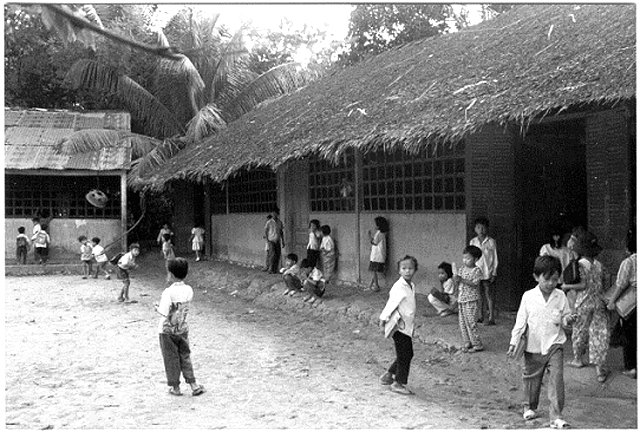
La vie dans le Sud de 1975 à 1985: Avec la politique de « contrôle de la société, de contrôle du peuple », le gouvernement communiste contrôla strictement le Sud viêtnamien. Il mit en place la police et des octrois sur les routes principales pour saisir des personnes et du matériel. Toute personne allant d’un district à un autre, tout transport de plus de 1 kilo de sucre, 1 kilo de riz, ou 1 kilo de viande devait avoir l'autorisation du gouvernement communiste. Les terres agricoles et les usines furent placées sous la direction du gouvernement. Les gens durent payer des impôts très élevés, de plusieurs fois ce qu'ils avaient payé aux colons français et environ 10 fois plus de ce qu'ils avaient payé à l'ancien gouvernement du Sud. Beaucoup d'agriculteurs du sud furent emprisonnés ou perdirent leurs terres au profit des communistes, car ils n'avaient pas assez d'argent pour payer les impôts élevés. Au cours de la période allant de 1976 à 1980, le riz des agriculteurs fut recueilli et entassé en tas en plein air humide et gâché par la pluie. Même si le pays était très pauvre, une grande partie du produit national fut perdue dans le système de distribution des méchants communistes. En conséquence, les populations furent physiquement et mentalement en mauvaise santé. La productivité baissa rapidement. La faim arriva droit dans le delta du Mékong, la région la plus riche du pays. Les étudiants de la compagne quittèrent l'école et les enseignants quittèrent la profession en raison de leur pauvreté. Dans de nombreux districts, les élèves venant à l'école durent transporter du riz ou des patates douces pour les donner à leurs enseignants, et les enseignants apportèrent de la crème glacée et des bonbons pour les vendre aux élèves pendant les récréations pour augmenter leurs revenus. Étant mal équipé et isolé du reste du monde, le système d'éducation nationale se détériora rapidement. À partir des enseignements économiques et sociaux du Nord après 1954 et du Sud après 1975, les viêtnamiens ont appris que, partout où les communistes ont pris le contrôle, les gens sont devenus affamés, sans instruction et le pays dans son ensemble a régressé. Après l'effondrement des communistes d'Europe orientale à la fin des années 1980, le viêt công commença à s'ouvrir aux réformes économiques. Mais les communistes dictatoriaux contrôlent toujours l'ensemble du pays, mettant un frein au progrès des viêtnamiens.
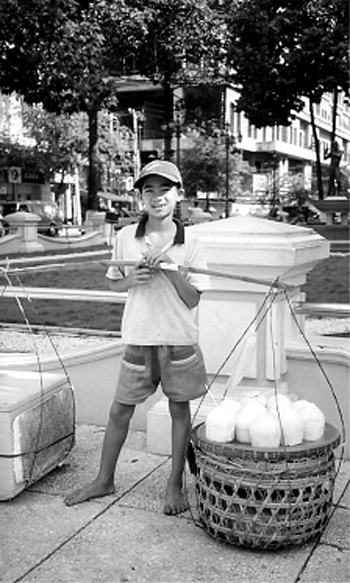
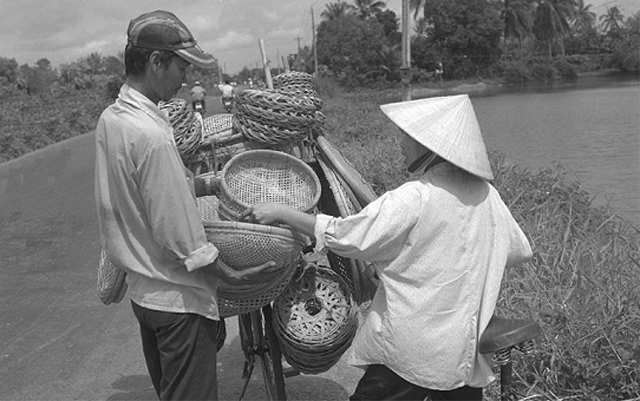
126. Đời sống của nông dân và công nhân miền Nam sau 1975: Giai cấp nông dân và công nhân là hai giai cấp nồng cốt dưới chế độ Cộng Sản. Cộng Sản Việt Nam long trọng tuyên bố đó là 2 giai cấp được yêu mến và ưu đải nhất trong xã hội. Sau khi chiếm được miền Nam, đảng Cộng Sản bắt đầu thu gom một số ruộng đất của nông dân vào hợp tác xã nông nghiệp. Sau mỗi mùa gặt, nông phẩm được tập trung vào kho, nông dân được tập họp nghe những bài nói chuyện dài lê thê về công ơn trời biển của đảng và của Bác Hồ đã hoàn toàn giải phóng nông dân khỏi sự bóc lột của xã hội tư bản. Ngày nay, nông dân là người chủ thật sự của ruộng đất (dù rằng đất của họ đã bị hợp tác xã chiếm hữu không bồi thường). Trước sự hiện diện của lính du kích có vũ trang, họ phải tự xúc lúa đóng thuế cho nhà nước, trả tiền xăng nhớt và phân bón cho hợp tác xã. Sau đó dến chủ nhiệm hợp tác xã và ban lãnh đạo lãnh phần. Rồi sau cùng đến phần nông dân chia nhau số lúa còn lại. Thường thì nông dân lãnh không tới một phần tư số lúa mà họ có được khi họ tự canh tác ruộng đất của họ trước kia. Mỗi hợp tác xã được chỉ huy bởi một chủ nhiệm là đảng viên đảng Cộng Sản Việt Nam. Chủ nhiệm và viên thơ ký chịu trách nhiệm chấm công hàng ngày cho nông dân và cho chính mình. Chủ nhiệm được công điểm cao nhất rồi đến bà con họ hàng của chủ nhiệm. Sau cùng là nông dân thường được điểm thấp nhất và chịu thiệt thòi nhất. Hậu quả là nông dân không còn chăm chỉ làm việc như xưa, sản lượng thấp, xã hội nghèo nàn và đói kém. Nông dân miền Bắc có bài hát để nêu lên tình trạng bất công nói trên:
"Mỗi người làm việc bằng hai,
Để cho chủ nhiệm mua đài, mua xe.
Mỗi người làm việc bằng ba,
Để cho chủ nhiệm xây nhà, xây sân !"
Về phía công nhân, họ cũng được học những bài học chính trị hàng tuần nói về công ơn trời biển của bác Hồ và của đảng Cộng Sản Việt Nam đã hoàn toàn giải phóng họ khỏi sự bóc lột của giai cấp tư bản, dù rằng đời sống vật chất của họ rất cơ cực và thiếu thốn nhiều. Họ được cho biết ngày trước họ làm ra sản phẩm chỉ để làm giàu cho chủ, còn họ không được đền bù xứng đáng. Ngày nay công nhân là những người chủ của đất nước vì thế họ cần phải làm việc nhiều hơn, tích cực hơn để xây dựng xã hội mới công bằng và hạnh phúc, không còn cảnh người bóc lột người. Sau đó công nhân được xếp loại theo bảng lương mới, thưng thì chưa tới 20% giá trị số lương trước kia. Hậu quả là công nhân nghèo đói phải đem bán những sản vật có giá trị như xe gắn máy, tủ lạnh, quần áo cho cán bộ Cộng sản là những người có nhiều tiền hơn, lãnh lương cao hơn. Đi sống của công nhân sa sút trầm trọng, nghèo nàn, ảnh hưởng đến sức khỏe, năng suất làm việc của toàn xã hội. Hậu quả là sản phẩm làm ra không có chất lượng. Một chiếc xe đạp quốc doanh mua về mới chạy một vài lần có thể gãy đổ bất thình lình, gây tai nạn cho người lái và khách đi đường. Vì hàng hóa không đủ tốt để cạnh tranh, xuất cảng, xí nghiệp không có tiền trả lương. Nhiều trường hợp công nhân được phát sản phẩm trừ lương. Thí dụ như, công nhân hãng thuốc lá được phát vài chục gói thuốc lá cho một tháng lương, công nhân hãng dệt lãnh khăn rằn thay lương, công nhân hãng ruột xe đạp lãnh vài cái ruột xe thay cho một tháng lương.
Life of the South farmers and the workers after 1975: Farmers and workers are two basic classes under Communism. Theoretically, they are the most favored and beloved by the communists. After capturing the South, the communists collected many of the farmlands into collective farms. After the harvest, rice and farm products were put into a temporary store. The farmers were gathered for long lectures about the great merit of the party and of uncle Ho, who had completely liberated them from the exploitation of the capitalist society. Now, farmers were the real owners of the cooperative and the whole country. Under the guns of the communist soldiers, farmers paid taxes with the rice, and also used the rice to pay the cooperative for gasoline and fertilizer. The leaders and the committee members took their rice. Then the farmers divided the rest of the food among themselves. Most of the time the farmers got less than a quarter of what they had when they worked by themselves. The leader gave him a daily rating on how well he had fulfilled his responsibilities. He also rated the farmers on how well they had done their duties. Usually, the leader gave him the highest score, and then gave his relatives the next highest score. Those who did the actual work—the farmers—got the lowest scores. Consequently, the farmers did not work as hard as before. The farm production went down. The society became poor and suffered hunger. Farmers had the following song to describe that unfair distribution:
“Each person works as double,
So the leader can buy his radio and his bicycle.
Each person works as triple,
So the leader can build his house and his yard !”
Workers also had to endure long lectures about the great merit of uncle Ho and the party who freed them from the exploitation of the capitalist class. They were told that they used to work hard to make the factory owners rich and their compensation was too little. Now they were the new owners of the whole country, so they had to work even harder to build up the new and happy society without the “exploitation of man by man”. Then the workers received new salaries according to a new scale. Unfortunately, most of them now brought home less than 20% of what they used to earn before. The workers were stripped to the bone. They had to sell most their valuable belongings to the communists, who had more money. Malnutrition has affected the health and the productivity of the workers. Products with poor quality were seen everywhere. For example, brand new bicycles from a state-ran factory might collapse all of a sudden, causing accidents on the street. Since products with poor quality could not compete in the international market, the state-ran factories did not have money to pay the workers. Many factories paid their workers with their products. For instance, a worker in a cigarette factory received two cartons of cigarettes for his monthly salary. A worker in a texture factory received a few towels for her salary. A worker in a bicycle tube factory had a few tubes for his monthly salary.
La vie des paysans du Sud et des travailleurs après 1975: Les
agriculteurs et les travailleurs sont deux classes de base sous le
communisme. Théoriquement, ils sont les plus favorisés et aimés des
communistes. Après la prise du Sud, les communistes rassemblèrent un
grand nombre de terres agricoles dans des fermes collectives. Après la
récolte, le riz et les produits agricoles furent emmagasinés
temporairement. Les agriculteurs furent réunis pour de longues lectures
sur le grand mérite du Parti et de l'oncle Hô, qui les avait
complètement libérés de l'exploitation de la société capitaliste.
Maintenant, les agriculteurs étaient les véritables propriétaires de la
coopérative et du pays tout entier. Sous les armes des soldats
communistes, les agriculteurs payèrent les taxes avec le riz, et
utilisèrent également le riz pour payer à la coopérative l'essence et
les engrais. Les dirigeants et les membres du comité prirent leur riz.
Ensuite, les agriculteurs divisèrent le reste de la nourriture entre
eux. La plupart du temps, les agriculteurs obtinrent moins d'un quart
de ce qu'ils avaient lorsqu'ils travaillaient pour eux-mêmes. Le chef
se donnait un avis quotidien sur la façon dont il s'était acquitté de
ses responsabilités. Il notait également les agriculteurs sur la façon
dont ils avaient accomplis leurs devoirs. Habituellement, le chef se
donnait la meilleure note, puis attribuait à sa famille la deuxième
note la plus élevée. Ceux qui avaient fait le travail en réalité
obtenaient les notes les plus basses. Par conséquent, les agriculteurs
ne travaillaient pas aussi dur qu’auparavant. La production agricole
diminua. La société devint pauvre et souffrit de la faim. Les
agriculteurs avaient la chanson suivante pour décrire la répartition
inéquitable:
« Chaque personne travaille deux fois plus,
Ainsi, le chef peut acheter sa radio et sa bicyclette.
Chaque personne travaille trois fois plus,
Ainsi, le chef peut construire sa maison et sa cour!
Les travailleurs eurent également à endurer de longues conférences sur
le grand mérite de l'oncle Hô et le parti qui les avaient libérés de
l'exploitation de la classe capitaliste. On leur dit qu'ils avaient
l'habitude de travailler dur pour enrichir les propriétaires d'usines
et que leur rémunération était trop faible. Maintenant, ils sont les
nouveaux propriétaires de l'ensemble du pays, de sorte qu'ils doivent
travailler encore plus dur pour construire la société nouvelle et
heureuse sans l'exploitation « de l'homme par l'homme ». Ensuite, les
travailleurs reçurent de nouveaux salaires selon un nouveau barème.
Malheureusement, la plupart d'entre eux ramenaient maintenant moins de
20% de ce qu'ils gagnaient avant. Les ouvriers furent dépouillés
jusqu’à l'os. Ils durent vendre leurs biens les plus précieux aux
communistes qui avaient plus d'argent. La malnutrition affecta la santé
et la productivité des travailleurs. Des produits de mauvaise qualité
furent vus partout. Par exemple, des vélos neuf d'une usine d’état
pouvaient se plier à tout à moment, causant des accidents dans la rue.
Comme ces produits de mauvaise qualité ne pouvaient pas rivaliser sur
le marché international, les usines d’état n'eurent pas d'argent pour
payer les travailleurs. De nombreuses usines payèrent leurs
travailleurs avec leurs produits. Par exemple, pour son salaire
mensuel, un travailleur dans une fabrique de cigarettes recevait une
vingtaine de paquets de cigarettes, un travailleur dans une usine de
textile quelques serviettes et un travailleur dans une usine de tubes
de bicyclette quelques tubes.
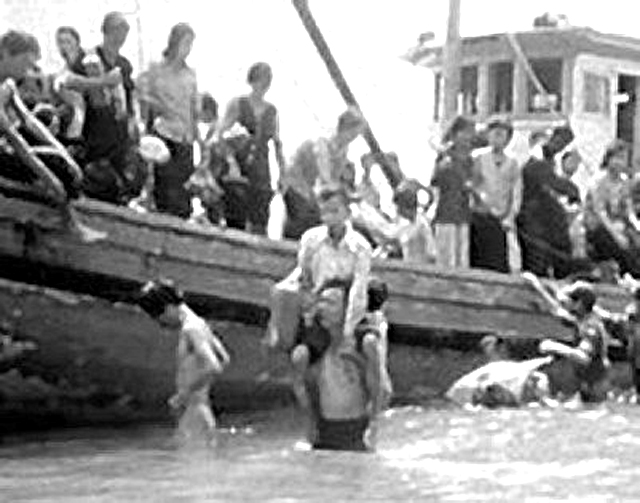
127. Cuộc vượt biên của người Việt Nam sau 1975: Sau khi chiếm được miền Nam năm 1975, Cộng Sản áp đặt sự cai trị tàn bạo lên cả nước. Quen sống trong một xã hội thoải mái, tương đối tự do, đồng bào miền Nam, kể cả những người từng theo Cộng Sản, cảm thấy khổ sở trong một xã hội mới độc tài, đầy bất công, phi lý. Họ bắt đầu vượt biên trốn chạy khỏi chế độ Cộng Sản từ năm 1975 cho đến hơn 20 năm sau. Phần lớn vượt biên bằng thuyền, một số vượt biên bằng đường bộ qua ngã Campuchia để đến Thái Lan . Một lần nữa, Cộng Sản xả súng bắn vào đồng bào vượt biên vô tội, giết chết nhiều người, bỏ tù, cướp bóc những người khác. Hàng trăm ngàn người chết trên biển cả, một số bị giết, bị hãm hiếp cướp bóc bởi hải tặc Thái Lan. Số còn lại, khoãng 2 triệu người đến được bến bờ, được Liên Hiệp Quốc giúp đở định cư tại một nước thứ ba. Trong lịch sử nước Việt Nam, có hai lần đảng Cộng Sản cướp được chính quyền: lần thư nhất năm 1954 tại miền Bắc, lần thứ hai vào năm 1975 tại miền Nam. Trong cả hai lần nói trên, hàng triệu con dân nước Việt đã ùn ùn bỏ chạy tị nạn Cộng Sản. Họ bỏ nhà cửa, vườn ruộng, xóm làng. Họ đã bị bắt, bị bắn và không biết bao nhiêu người đã bỏ thây trên biển cả.
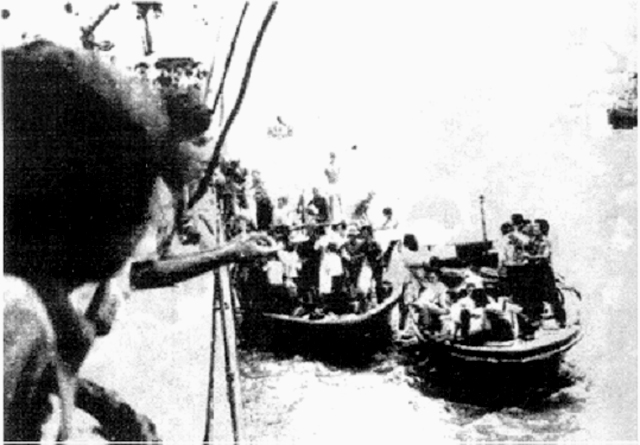
The escape after 1975, boat people: After capturing the South in 1975, the VC set brutal control upon the whole country. Being familiar with a relaxing, free society, the southern Vietnamese felt unhappy in the new dictatorial society with full of unfair and unreasonable treatment. The Vietnamese escaped the communist regime from 1975 to 1995. Most of them escaped by boat, some walked through Cambodia to Thailand. Again the communist shot at the innocent escapees, killed, robbed and imprisoned many of them. Hundreds of thousands of the boat people died in the sea, while the other were killed, raped, and robbed by the Thailand pirates. More than one million of them reached the lands of the neighbor countries like Thailand, Philippine, Malaysia, Indonesia, Hongkong, Singapore... The refugees received help from the neghbor countries and the United Nations to resettle in a third country. In the history of Vietnam, the communists gained the power twice. The first time in 1954, when they stole the government in the North, the second time in 1975, when they captured the South. And in both times, millions of Vietnamese fled for their lives and their freedom. They had to run away from their homeland and their villages. A countless number of them have been shot at, imprisoned and killed on the way searching for freedom.
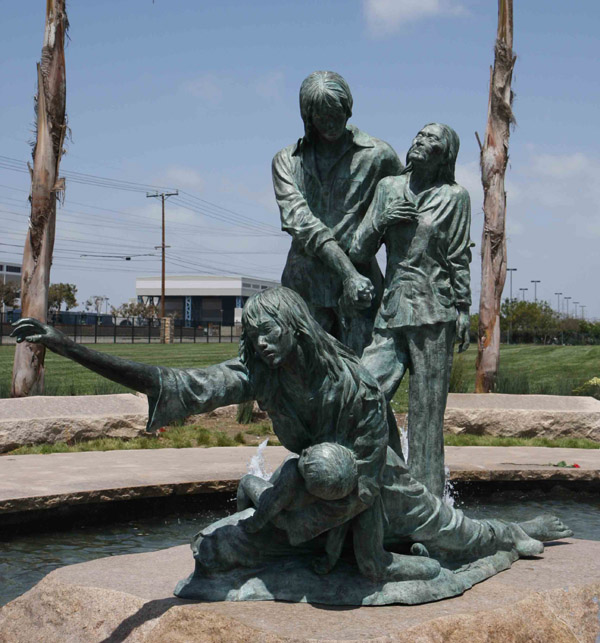
Le monument des Boat People érigé au sud de la Californie remémore la mort de nombreux compatriotes lors de leur fuite du régime communiste brutal et cruel. Cette image et beaucoup d’autres monuments érigés dans d’autres pays du monde en mémoire aux victimes du communisme n’effaceront jamais les flétrissures de l’histoire humaine.
La fuite après 1975, les boat people: Après la prise du Sud en 1975, le viêt công prit le contrôle brutal de l'ensemble du pays. Etant familiarisés avec une société décontractée et libre, les viêtnamiens du sud se sentirent malheureux dans la nouvelle société dictatoriale pleine d’injustice et de mauvais traitements. Les viêtnamiens fuirent le régime communiste de 1975 à 1995. La plupart d'entre eux s'échappèrent par bateau, certains marchèrent à travers le Cambodge pour rejoindre la Thaïlande. Encore une fois les communistes tirèrent sur les fugitifs, tuant, volant et emprisonnant beaucoup d’entre eux. Des centaines de milliers de boat people sont morts en mer, tandis que d’autres furent tués, violés et volés par les pirates Thaïlandais. Plus d'un million d'entre eux atteignirent les terres des pays voisins comme la Thaïlande, les Philippines, la Malaisie, l’Indonésie, Hongkong, Singapour. Les réfugiés reçurent de l'aide de ces pays voisins et des Nations Unies pour se réinstaller dans un pays tiers. Dans l'histoire du Viêt-Nam, les communistes ont acquis le pouvoir à deux reprises. La première fois en 1954, quand ils volèrent le gouvernement du Nord, la deuxième fois en 1975, quand ils capturèrent le Sud. Et par deux fois, des millions de viêtnamiens durent fuir pour sauver leur vie et leur liberté. Ils durent fuir leurs foyers et leurs villages. Un nombre incalculable d'entre eux furent fusillés, emprisonnés et tués sur la route en quête de liberté.
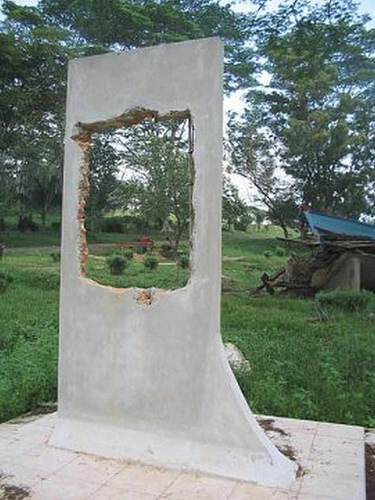
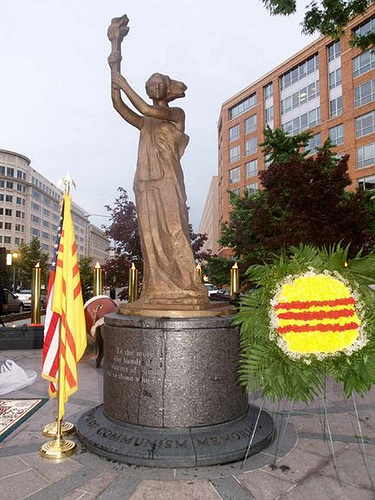

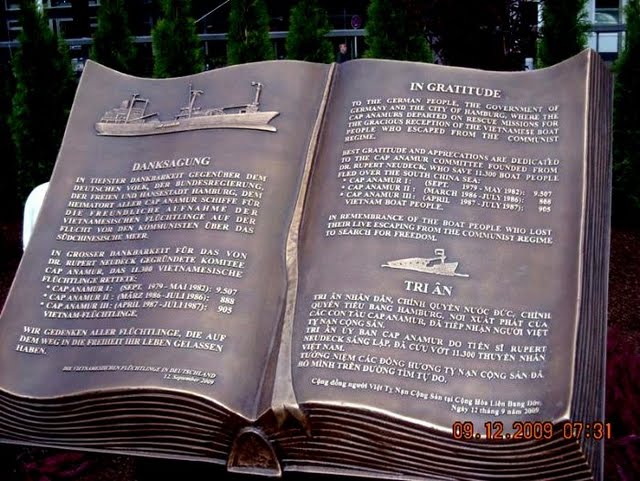

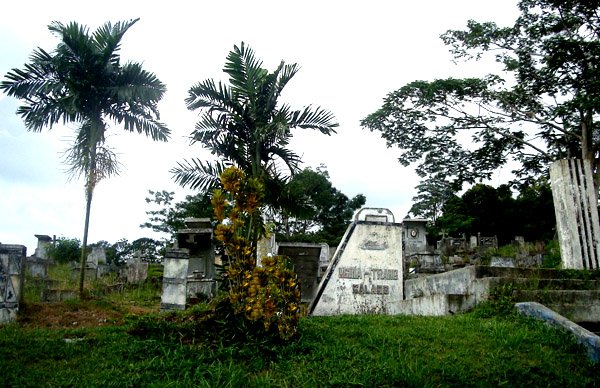
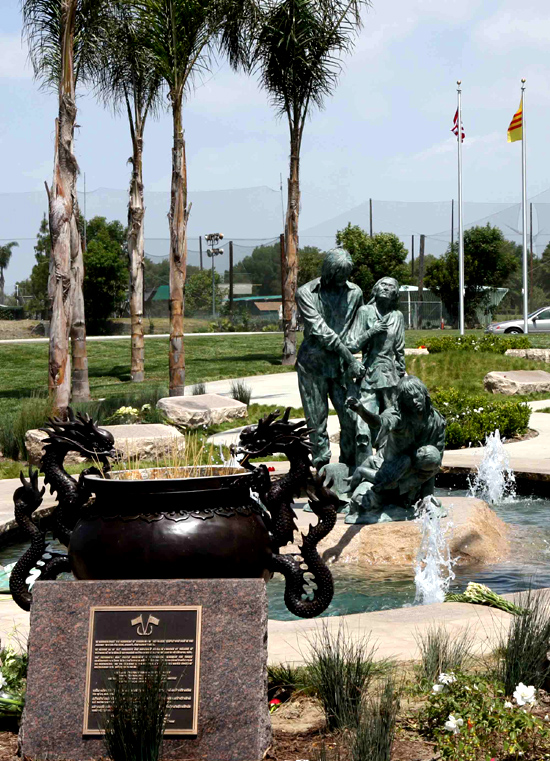
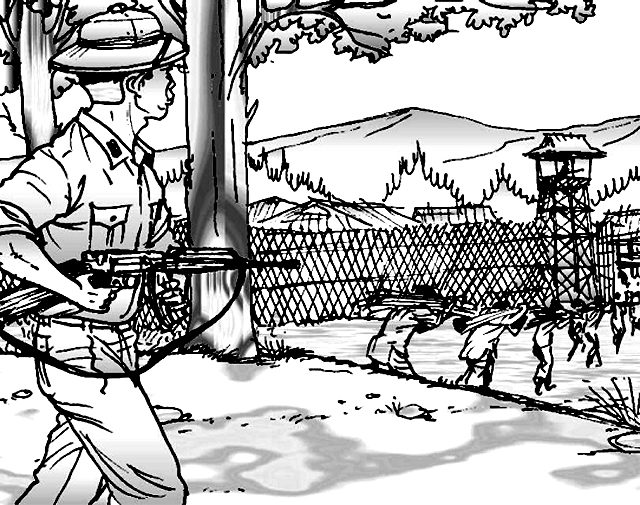
128. Trại tù tập trung: Tháng 6 năm 1975, Cộng Sản ra lịnh cho tất cả sĩ quan và một số binh lính miền Nam chuẩn bị học tập 1 tháng để được hưởng chính sách ''khoan hồng'' của nhà nước. Mỗi người phải đóng 11.500$ cho 1 tháng thực phẩm. Sau đó họ bị nhốt vào các trại tập trung không đủ thực phẩm, thuốc men và bị buộc lao động khổ sai dài hạn. Đa số bị giam từ 5 đến 15 năm, có người bị nhốt trên 20 năm. Một số chết vì bịnh hoạn và thiếu thực phẩm ngay trong trại tập trung. Một số khác chết sau khi bị thả về vì những căn bệnh hiểm nghèo mắc phải trong thời gian lao động khổ sai. Những quân nhân bị tù đày trên 3 năm được chính quyền Hoa Kỳ bảo trợ sang định cư ở Mỹ theo diện nhân đạo HO.
The concentration camps: In June 1975, the VC requested all officers and officials of the South to go to an “educational” school for one month, following the “merciful” order of the new government. They had to bring with them $11,500 for the cost of one month’s food. Finally, they were imprisoned in concentration camps, forced to do long term labor without enough food and medicine. Most of them were in the concentration camps for from 5 to 15 years, while some over 20 years. Many of them died in the camps due to lack of food and medicine. Many others died after going home, resulting of serious sicknesses during the hard labor time. Most of the survivors were sponsored to America by the U.S. government.
Les centres de détention: En Juin 1975, le viêt công pria tous les officiers et les fonctionnaires du Sud d’aller dans une école « d’éducation » pendant un mois, suivant l’ordre de « clémence » du nouveau gouvernement. Ils durent amener avec eux 11500 $ pour le coût d'un mois de nourriture. Enfin, ils furent emprisonnés dans des camps, forcés de travailler sans relâche sans assez de nourriture et de médicaments. La plupart d'entre eux y restèrent pendant 5 à 15 ans tandis que certains y restèrent plus de 20 ans. Beaucoup d'entre eux moururent y en raison du manque de nourriture et de médicaments. Beaucoup d'autres moururent après être rentrés à la maison du fait des maladies graves contractées pendant le temps de travail forcé. La plupart des survivants furent recueillis en Amérique par le gouvernement américain.
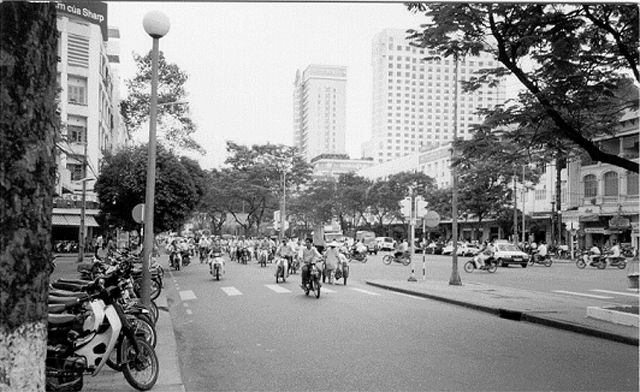
129. Đời sống ở Việt Nam sau năm 1985: Từ sau năm 1985, phần lớn các nước Cộng Sản trên thế giới dần dần trở nên yếu kém và tan vỡ. Để tránh bị sụp đổ, Cộng Sản Việt Nam mở cửa giao thương với các nước tự do để tự cứu mình. Dân chúng được phép buôn bán và sở hữu ruộng đất, nền kinh tế chết đói của Việt Nam bắt đầu hồi phục. Tuy nhiên Việt Nam vẫn không có dân chủ, nhân quyền. Chỉ có đảng viên đảng Cộng Sản mới được kinh doanh các ngành kinh tế tốt nhất và giử các chức vụ quan trọng trong mọi ngành nghề. Đảng Cộng Sản Việt Nam trở thành một đảng tham nhũng bậc nhất của thế giới, và dân chúng vẫn phải đóng thuế nặng nề để nuôi dưỡng một chế độ tàn ác, độc tài và bất công. Phần lớn đảng viên đảng Cộng Sản trở nên khá giả trong khi đại đa số dân chúng sống trong nghèo đói. Lương chánh thức của một đảng viên chưa tới 100$ Mỷ kim một tháng. Nhờ vào ăn hối lộ, chiếm hữu của dân, ăn cắp của công, đảng viên đảng Cộng Sản Việt Nam trở thành những người giàu có nhất. Đảng viên càng cao cấp thì càng giàu. Phần lớn họ có nhà đẹp, xe cộ mắc tiền, trong một đất nước nghèo nàn thu nhập bình quân năm 1999 chưa tới 25 Mỹ kim một tháng. Các quyền tự do căn bản của người dân vẫn bị cướp mất. Trong hoàn cảnh đói khổ và bị lường gạt liên tục bởi chính quyền cộng sản, người dân mất lòng tin, mất dần những đức tính cao quý của dân tộc như lòng thương yêu, chia xẻ, lòng nhân từ, bao dung. Nhìn trở lại, điều Cộng Sản làm trước tiên sau khi chiếm được miền Nam là bắt nhốt những người đàn ông khỏe mạnh, có năng lực xây dựng xã hội. Kế đó họ chiếm đoạt nhà cửa, tài sản của những gia đình giàu có, khá giả. Kế đó họ cho đổi tiền nhiều lần với những tỉ lệ bất công làm cho dân chúng miền Nam trở nên nghèo đói. Họ cho cán bộ Cộng sản miền Bắc vào khống chế các ngành giáo dục, thông tin, văn hóa của miền Nam làm cho đời sống tinh thần, đạo đức của dân chúng sa sút trầm trọng. Sau cùng họ dùng chính sách sưu cao, thuế nặng, hợp tác hóa, quốc doanh hóa để phá hoại nền nông nghiệp và công nghiệp của miền Nam. Hậu quả là sau 25 năm sống trong chế độ Cộng Sản, Việt Nam trở thành một trong những nước suy đồi và nghèo đói nhất trên thế giới. Cán bộ Cộng Sản ngày một giàu có trong khi dân chúng ngày một nghèo khổ nhưng không có một phương tiện tối thiểu để kêu than. Mỗi năm Việt kiều hải ngoại gởi về nước hàng tỉ Mỹ kim để cứu đói thân nhân. Nhưng tiền bạc không thể mang đến tự do, dân chủ cho đất nước.
The life of the Vietnamese after 1985: After 1985, many communist countries became weak and broken. To avoid being collapsed, the Vietnamese communist opened the country up to have international relations with other countries. The Vietnamese people are allowed to have individual businesses, and own private land. The starving economy gradually recovered. However, there is still no democracy and no basic human rights. Only high-ranking communists are allowed to invest in high returning and important business or to hold high position in factories. The Vietnamese communist party becomes one of the most corrupted parties on earth. They take all chances to squeeze money from people. The Vietnamese people continue to pay high tax to feed a cruel, dictatorial, and discriminating regime. Most of the communist leaders have become very rich while the major popularity is still living in poverty. While the basic salary of a communist member is under 100 US dollars per month, most of them become rich by bribing, capturing people’s property, and stealing the country’s resource. They possess many big homes, cars and motorcycles in the country where average monthly income per citizen is under 25 US dollars in 1999. All basic human rights are stolen away. To date, the entire country is being stripped and cheated by the government, the Vietnamese are gradually loosing their faith, and their traditional valuable characteristics such as love, sharing, humanity, and forgiveness. Looking back, the first thing that the communists did after the capturing the South was putting the strong men of the South into the concentration camps. Next, they seized the properties of the rich. Then they changed the national currency several times with unfair rate to make the southerners poor. The communist cadres ruled the education, communication, and cultural branches of the South, destroying the spiritual, and moral lives of people. And finally, they use high tax, collaborate, state-run policies to destroy the agriculture and light industries of the South. The communist cadres become richer while general public become poorer and have no mean to complain for themselves. The overseas Vietnamese send back billions of dollars yearly to help their relatives. However, money alone cannot bring the country to freedom and democracy.
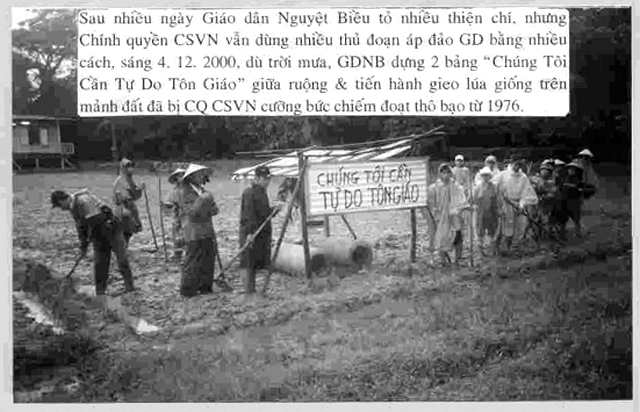
La persécution religieuse est toujours sévère. Mais le peuple viêtnamien se bat toujours silencieusement pour ses droits. Les photos prises en 2000 montrent les chrétiens de l’église Nguyệt Biều réunis ensembles malgré le danger pour cultiver la terre de l’église confisquée par le viêt công en 1976.
Depuis plusieurs jours, les chrétiens de Nguyêt Biêu ont montré beaucoup de volonté bien que le gouvernement communiste viêtnamien d’une façon rusée les ait opprimés de plusieurs manières. Le 4 décembre 2000, alors qu’il pleuvait, les chrétiens ont érigé deux panneaux au milieu d’une rizière sur lesquels ils ont inscrit cette phrase : « NOUS AVONS BESOIN DE LIBERTE DE RELIGION » Ils ont continué à planter du riz sur le terrain que les communistes viêtnamiens leur avaient confisqué en 1976.
La vie des viêtnamiens après 1985: Après 1985, de nombreux pays communistes devinrent faibles et s’effondrèrent. Pour éviter l’effondrement, les communistes viêtnamiens ouvrirent le pays pour entretenir des relations internationales avec d'autres pays. Le peuple viêtnamien fut autorisé à posséder des entreprises individuelles et à posséder des terres privées. L'économie de subsistance se rétablit graduellement. Cependant, la démocratie et les droits humains fondamentaux n'existent toujours pas. Seuls les communistes de haut rang sont autorisés à investir dans des affaires de bon rapport et dans des affaires importantes ou à occuper un poste élevé dans les usines. Le parti communiste viêtnamien est devenu l'un des partis les plus corrompus de la planète. Il prend toutes les occasions de soutirer de l'argent au peuple. Le peuple viêtnamien continue de payer des impôts élevés pour nourrir un régime cruel, dictatorial, et discriminatoire. La plupart des dirigeants communistes sont devenus très riches alors que la majorité de la population vit encore dans la pauvreté. Alors que le salaire de base d'un communiste est inférieur à 100 dollars US par mois, la plupart d'entre eux deviennent riches en corrompant, saisissant les biens des gens et en volant les ressources du pays. Ils possèdent de nombreuses maisons de grosses voitures et des motos dans le pays où le revenu mensuel moyen par habitant est inférieur à 25 dollars US en 1999. Tous les droits humains fondamentaux sont violés. À ce jour, le pays entier est dépouillé et trompé par le gouvernement, les viêtnamiens perdent progressivement leur foi, et leurs valeurs traditionnelles telles que l'amour, le partage, l'humanité et le pardon. Rétrospectivement, la première chose que les communistes ont faite après la capture du Sud fut de mettre les hommes forts du Sud dans des camps de concentration. Ensuite, ils saisirent les biens des riches. Puis ils changèrent la monnaie nationale à plusieurs reprises avec un taux de change injuste afin de rendre les gens du Sud pauvres. Les cadres communistes régirent l'éducation, la communication, et les ramifications culturelles du Sud, détruisant le spirituel, et la vie morale des personnes. Et enfin, ils utilisèrent des impôts élevés, mirent en pratique des politique d’état visant à détruire l'agriculture et les industries légères du Sud. Les cadres communistes devinrent plus riches alors que la population générale devint plus pauvre et n'eut aucun moyen de se plaindre d'elle-même. Les viêtnamiens à l'étranger envoient des milliards de dollars par an pour aider leurs parents. Cependant, l'argent seul ne peut pas amener le pays à la liberté et la démocratie.
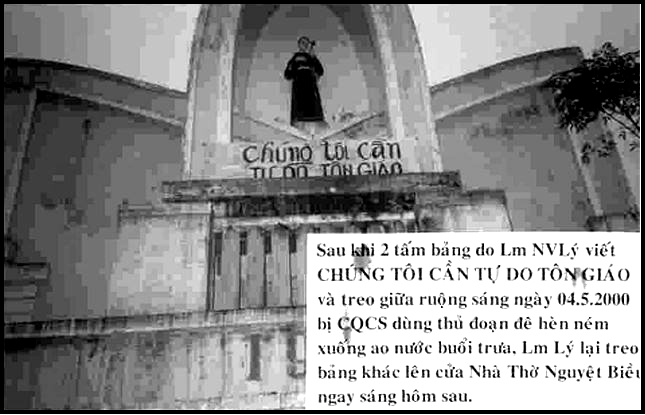 "Chúng
Tôi Cần Tự Do Tôn Giáo". Đó là lời kêu thống thiết của giáo dân Thiên
Chúa Giáo xã Nguyệt Biều. Mà đó cũng là lời kêu thống thiết đòi hỏi
quyền làm người của cả dân tộc Việt Nam. Hình chụp năm 2000 tại nhà thờ
Nguyệt Biều.
"Chúng
Tôi Cần Tự Do Tôn Giáo". Đó là lời kêu thống thiết của giáo dân Thiên
Chúa Giáo xã Nguyệt Biều. Mà đó cũng là lời kêu thống thiết đòi hỏi
quyền làm người của cả dân tộc Việt Nam. Hình chụp năm 2000 tại nhà thờ
Nguyệt Biều. "Nous avons besoin de la liberté religieuse." Cette phrase prononcée avec douleur par les paroissiens du village de Nguyệt Biều exprime aussi la revendication de tout le peuple Viêtnamien pour les droits de l’homme. Photo prise en l’an 2000 à l'église de Nguyệt Biều.
Après que le prêtre Nguyên Van Ly ait rédigé sur 2 panneaux « NOUS AVONS BESOIN DE LIBERTE DE RELIGION » et les ait affichés, les communistes les ont jetés dans le marais. Le lendemain le prêtre Ly en accrocha un autre sur le fronton de l’église.
130. Vi phạm nhân quyền trong xã hội Cộng Sản: Cũng như bất cứ nước Cộng Sản nào khác trên thế giới, Cộng Sản Việt Nam luôn luôn chà đạp nhân quyền của người dân. Dù rằng nước Việt Nam Cộng sản đã gia nhập Liên Hiệp Quốc và đã long trọng ký kết tôn trọng bảng Tuyên Ngôn Quốc Tế Nhân Quyền, đãng Cộng Sản Việt Nam luôn luôn vi phạm trầm trọng các điều khoản 17, 18, 19, 20, 21, 22, 23 và 30 của bản Tuyên Ngôn nầy. Cụ thể, Cộng Sản vi phạm những quyền tự do tư tưởng, tự do ngôn luận, tự do báo chí, tự do tín ngưỡng, tự do cư trú, và tự do thành lập hội đoàn, đảng phái của người dân. Họ che dấu hoặc luôn luôn giải thích sai lạc các văn kiện của Liên Hiệp Quốc để đánh lừa dư luận quốc tế và quốc nội. Thí dụ người dân có quyền tự do báo chí nhưng không được viết bài hay xuất bản báo. Người dân có quyền tự do ngôn luận nhưng không được quyền phê phán nhà cầm quyền. Người dân có quyền tự do đảng phái và hội họp nhưng không được gia nhập hay thành lập những đảng phái không do nhà nước tổ chức. Người dân có quyền tự do bầu cử, ứng cử nhưng chỉ có thể đi bầu trong danh sách ứng cử viên của nhà cầm quyền đã chọn sẵn, mà hầu hết là đảng viên. Người dân có quyền tự do tôn giáo nhưng khi họp mặt hành lễ phải xin phép nhà cầm quyền. Chùa chiền hay nhà thờ có thể bị nhà cầm quyền chiếm dụng bất cứ lúc nào. Mặc dù Việt Cộng luôn phủ nhận vi phạm nhân quyền, tháng 10 năm 1999 Liên Hiệp Quốc dùng thủ tục số 1503 truy tố nhà cầm quyền Hà nội ra tòa án quốc tế tội vi phạm nhân quyền có hệ thống. Đến đầu năm 2000 cuộc xét xử còn đang tiếp diễn.
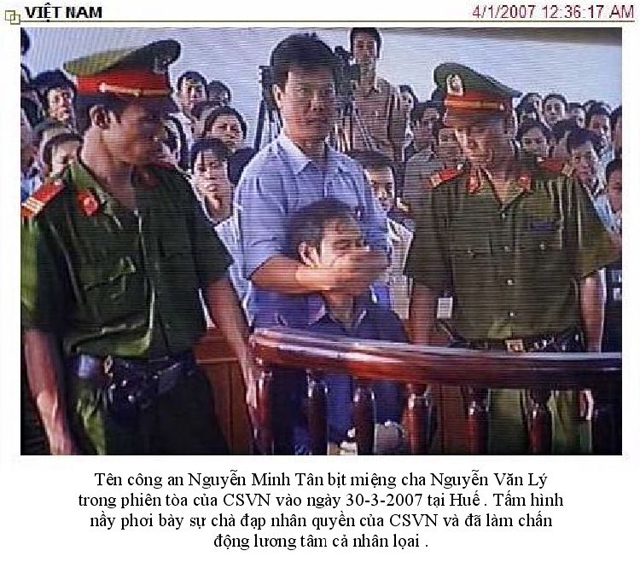 Hình
chụp một công an mặc thường phục ngang nhiên bịt miệng cha Lý trước tòa
án thành phố Huế ngày 30-3-2007. Sự việc chà đạp nhân quyền xảy ra
thường xuyên trong các nước Cộng Sản nhưng nhưng luôn bị che đậy, giấu
diếm. Tấm hình hiếm hoi nầy đã được phổ biến trên toàn thế giới và đã
làm chấn động lương tâm nhân loại.
Hình
chụp một công an mặc thường phục ngang nhiên bịt miệng cha Lý trước tòa
án thành phố Huế ngày 30-3-2007. Sự việc chà đạp nhân quyền xảy ra
thường xuyên trong các nước Cộng Sản nhưng nhưng luôn bị che đậy, giấu
diếm. Tấm hình hiếm hoi nầy đã được phổ biến trên toàn thế giới và đã
làm chấn động lương tâm nhân loại.L’agent de sécurité Nguyên Minh Tân ferme la bouche du prêtre Nguyên Van Ly au tribunal à Huê le 30 mars 2007. Cette photo montre la violation violente des droits de l’homme. Cela affecte l’ensemble du monde.
The violation of human rights in the communist regime: Similar to other communist countries on earth, the Vietnamese communists always infringe the human rights of their people. Even though Viet Nam has joined the United Nations and seriously pledged to respect the International Bill of Human Rights, the communist party always violates the articles 17, 18, 19, 20, 21, 22, 23, and 30 of this Bill. For instance, they violate the freedom of opinion and expression, freedom of press, freedom of religion, freedom of movement and resident, and freedom of assembly and association of Vietnamese people. They always cheat by explaining in wrong ways the documents of the United Nations. For instance, the communists declare that Vietnamese people have the freedom of press but cannot publish newspapers or magazines; freedom of speech but cannot criticize the government; freedom of associate but cannot create or join parties; freedom of voting but can only vote in the list from the government where the most of the candidates are the party members; freedom of religion but the religious meetings are under strict control; the temples and churches can be captured by the communists at any time. Even though the communists always deny that they violate the human rights of people, on October 1999, the United Nations used the legal procedure 1503 to bring Ha Noi to the international court for insistent violation of human rights. The conviction is ongoing.
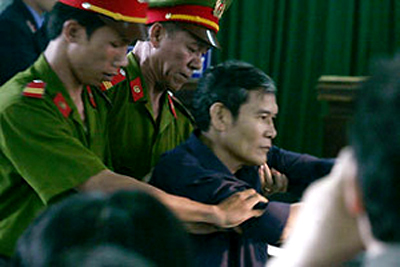
Dù chỉ là một ông Cha hiền lành, lẽ ra phải được kính trọng trong một xã hội bình thường, linh mục Nguyễn Văn Lý luôn bị nhà cầm quyền Cộng Sản bắt bớ và giam cầm trong suốt cuộc đời hành đạo của Ngài. Hình chụp cảnh Cha Lý trước tòa năm 2007.
Dans une société normale, il faut respecter les prêtres. Le père Nguyên Van Ly a été battu et emprisonné toute sa vie de prêtre. Photo du Père Ly devant la Cour du tribunal en 2007.
La violation des droits de l'homme dans le régime communiste: A l'instar d'autres pays communistes sur terre, les communistes viêtnamiens enfreignent toujours les droits de l'homme de leur peuple. Même si le Viêt-Nam a rejoint l'Organisation des Nations Unies et s’est sérieusement engagé à respecter la Charte internationale des droits de l'homme, le Parti communiste viole toujours les articles 17, 18, 19, 20, 21, 22, 23 et 30 de cette charte. Par exemple, ils violent la liberté d'opinion et d'expression, la liberté de la presse, la liberté de religion, la liberté de circulation et de résidence, la liberté de réunion et d'association du peuple viêtnamien. Ils trompent toujours en expliquant de façon erronée les documents de l'Organisation des Nations Unies. Par exemple, les communistes viêtnamiens déclarent que les gens ont la liberté de la presse, mais ne peuvent publier des journaux ou des magazines, la liberté de parole, mais ne peuvent pas critiquer le gouvernement, les partis la liberté de s'associer, mais ne peuvent en créer ou en rejoindre, la liberté de vote, mais ne peuvent voter que dans la liste du gouvernement où la plupart des candidats sont les membres du parti, la liberté de religion, mais les réunions de culte sont sous contrôle strict ; les temples et les églises peuvent être saisis par les communistes à tout moment. Même si les communistes nient toujours qu'ils violent les droits fondamentaux des personnes, en octobre 1999, les Nations-Unis ont utilisé la procédure juridique 1503 pour amener le gouvernement de Hà Nôi devant la cour internationale pour violation constante des droits humains. Le procès est en cours.
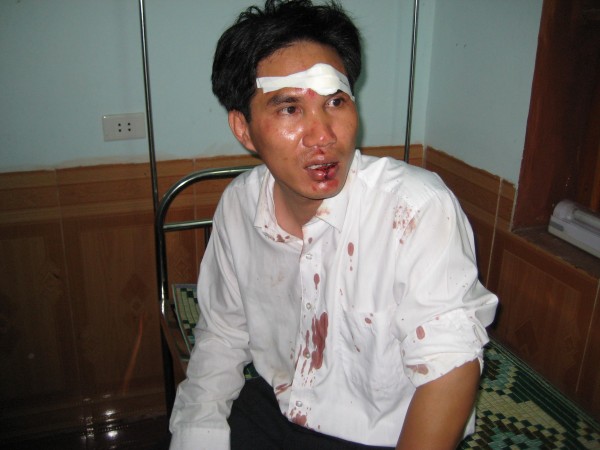
La religion est toujours fortement opprimée. Le prêtre Ngô Thế Bính a été battu brutalement par les communistes viêtnamiens en 2009 uniquement parce qu’il avait défendu l’église Tam Toà que les communistes avait confisquée.
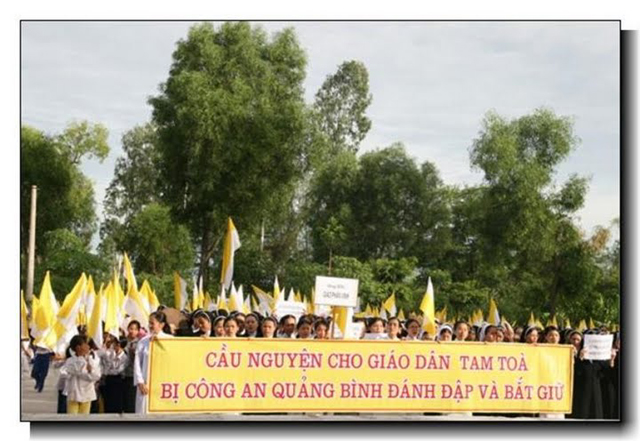
Cette photo prise en 2009 montre des chrétiens en meeting d’opposition aux communistes ayant battu, emprisonné illégalement des paroissiens de l’Eglise Tam Toà.
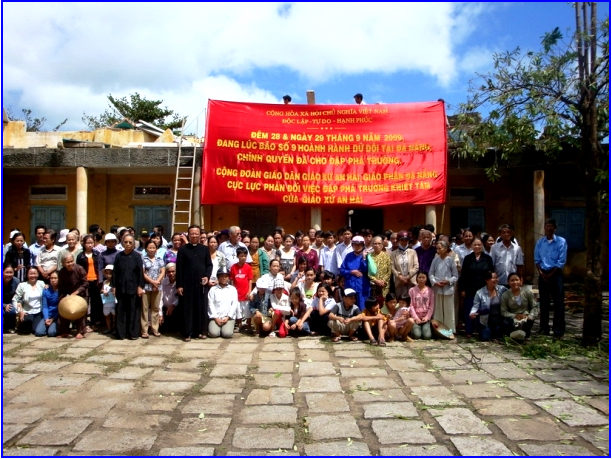
La persécution religieuse est toujours sévère. L’image prise en 2009 montre des paroissiens de l'église de An Hải, Dà Nang protester contre la destruction de l'école Khiết Tâm de l’église paroissiale par le viêt công.
Trở Về Trang Gốc Lịch Sử Việt Nam